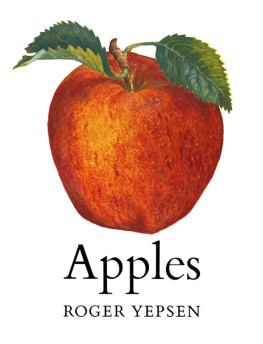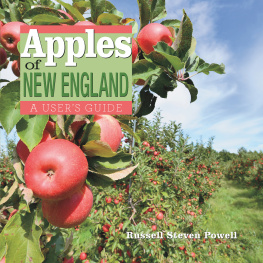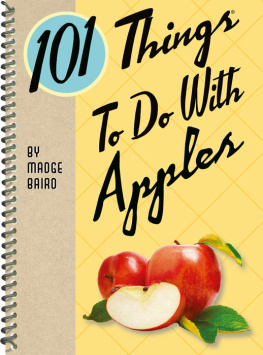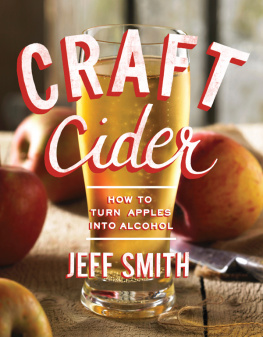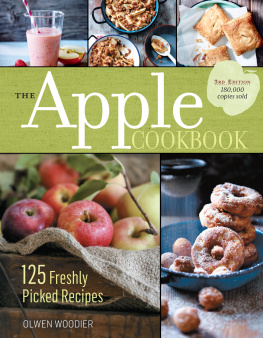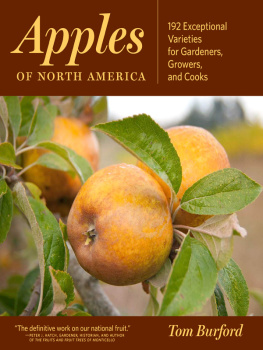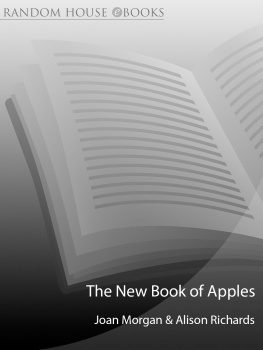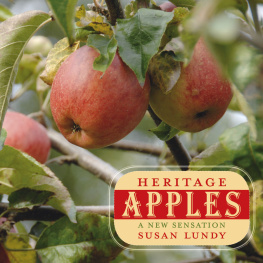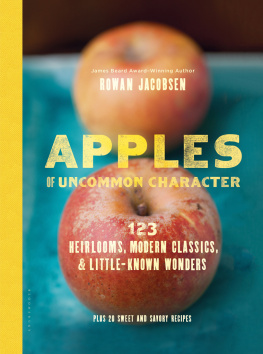
Apples

WRITTEN & ILLUSTRATED BY
ROGER YEPSEN
W. W. NORTON & COMPANY
NEW YORK LONDON
To my uncle Rhodes Copithorn,
who was inspired by the great old Northern Spies
in his Long Island backyard
to look for an orchard of his own;
to my grandfather Defoe Mosher,
who grew Jonathans, Winesaps, Northern Spies, Rhode Island
Greenings, and Grimes Golden on his Indiana farm;
and to my great-grandmother Edna Bloom Carter,
who made pies from the two unpruned Yellow Transparents
behind her house.

Apples, Red, round, crisp, and cool.
The list of adjectives doesnt have to stop there. An apple can be much more than the generic red orb weve come to expect from the supermarkets produce department.
The orchards of North America have produced well over a thousand named apple varieties. Each one, with its characteristic color, heft, and aura, is as distinctive as a gemstone. Some apples are mysterious and hard to get to know. Others are as accessible as a carrot.
There are fruity apples tasting of banana, mango, pineapple, and pear, and spicy apples tasting of licorice, cinnamon, coriander, rue, and nutmeg. Apples can be had candy sweet or cider sour, cleanly astringent or mild-mannered, and hard as a raw potato or messy as a peach.
The best-known varieties tend to be quite round and smooth. But others are shaped like toy tops or lopsided old pillows and may have skins that look scarred and unpalatable to the unaccustomed eye. A few, such as the homely Knobbed Russet, dont look like apples at all. Sizes vary from the crabs, each just an inch across, to branch-bending giants the size of a babys head and weighing well over a pound.
Colors range from near white to forgettable beige to the deep, waxy near black of a showroom limo. And thats not to mention the reds, in uncountable shades, patterns, and levels of opacity and luminosity. An apples red coat overlies a layer of yellow or ocher or green that will either set the apple ablaze or mute it. A Staymans red is transposed to a minor key by the green pigment below. But on a Winter Banana or Ozark Gold, the red blush acts like a lens, incandescing with the light that reflects up through it.
Many apples are pedigreed, as their names suggest. Esopus Spitzenburg, Coxs Orange Pippin, and Duchess of Oldenburg are pomological royalty. The newer varieties have yet to acquire folklore status and tend to sound like supermarket products (Splendor, Sundowner), corporate mergers (Delcon) or, worse still, hybrid tomatoes (Pink Satin, Red Baron, Nova Easygro).
Apples have the diversity, lore, and subtlety of good wine. But in North America that great wealth has been wasted on most of us, most of the time. As apple customers we pick vanilla when presented with a choice of apples. Even 250 apples.
Thats a rough count of the varieties offered by Fred Jansons roadside apple business outside Rockton, Ontario. In a lifetime Americans sample an average of six. So, how do customers respond to this mans cornucopia?
Of the people who stop here, Janson says, maybe ninety-five percent want McIntosh or Yellow Delicious or one of the supermarket apples.
The long winter of our indifference has extinguished hundreds of quirky and appealing apple varieties, and made others almost impossible to find. The names remain to suggest what once was there for the picking: Bascombes Mystery, Stump of the World, Horneburger Pancake (one slice filled a pan). Weve made do with supermarket apples that have been chosen less for flavor than for bright, cheery color and sturdiness in transit. Thats why Red Delicious, Golden Delicious, and McIntosh, making up more than half of the apples grown in the United States, routinely lose taste tests to apples youve never heard of.
OUR FRUITED PLAIN
It has not always been this way. America once was a land of apple lovers. The favorite varieties of our colonial heroes have become well-known details of their biographies. George Washingtons most famous horticultural exploit may have been leveling a cherry tree, but as an adult he built a distillery for making apple brandy and was a fan of Newtown Pippins. Benjamin Franklin liked this apple so much that he had barrels of them shipped to England while lobbying there for the colonies. John Adams is said to have begun each day with a tankard of cider and was moved to write an ode to the beverage. Thomas Jefferson identified Esopus Spitzenburg as his pick of the apple varieties grown in the hilly orchards of Monticello.
Free-sowing Johnny Appleseed became a fixture of American folklore. His apples might not have been impressivethe seeds of a great variety rarely grow up into anything special but his spirit outlived his trees. Meanwhile, out in the orchards thousands of unsung amateurs were experimenting with promising varieties. Any fencerow seedling was a potential candidate for a new name and local renown. In fact, most of our varieties are love children, the products of chance pollination between unknown parents a century ago. Every region had several of these apples, each with its special talents: flavor, aroma, picking time, storability, resistance to disease. There were famous cider apples, baking apples, sauce apples, drying apples, and dessert apples.
Before mechanical refrigeration was used to prolong the life of produce, families bought a succession of seasonal favorites from summer through late fall, when the long-keeping winter apples could carry them through midsummer. One British visitor to the new United States remarked that apples were available eleven months of the year. And apples were consumed year-round as cider, Americas most popular drink among rich and poor, young and old.
Apples could be both a staple food and an object of connois-seurship. At rural kitchen tables, apple pies and tarts were served as routinely as bread. And the better city restaurants served dessert apples in little individual boxes, stem and two leaves attached, with a card noting variety and grower.
Before the time when Americans became identified as fans of sports teams, they were known for their favorite apples. People were even described as apples: crabs, bad apples, apple polishers, apples of ones eye. To describe the narrow, in-grown persona of small-town Americans, novelist Sherwood Anderson came up with twisted apples.
By 1900 a thousand varieties were sold in Americas markets. But changes were under way that were to consign most of those apples to obscurity.
THE REDDENING OF AMERICA
The squandering of our great apple heritage has been laid at the pesticide-spattered work boots of modern orchardists. It has been said they would rather market a few easy-to-ship apples than bother with an orchard full of antique oddballs.
Thats a simple explanation, and not a very good one. It ignores the curious thing that happened to us consumers when we glimpsed perfection in the form of a flawless, waxen, carmine applethe perfection that chemicals have made possible. Having partaken of this gorgeous fruit, we would accept no less. Spotted, modest-size, off-red apples now looked flawed or damaged. And so it was that growers became hooked on a regimen of spraying the daylights out of a few highly marketable varieties. Mechanical refrigeration further reduced the number of apples sold, by allowing a handful of varieties to be stored forever and shipped anywhere.
If commercial orchardists were to be faulted for anything, it was for following good business practice. The push for maximum yields per acre and efficient production slighted apples that werent round enough, big enough, or tough enough. In the new order, a key advantage of a variety was that it have a long stem, to permit better penetration by sprays. Another was that it be typy, industry lingo for an apple that closely mimics a nationally known variety and can ride on its coattails.
Next page
